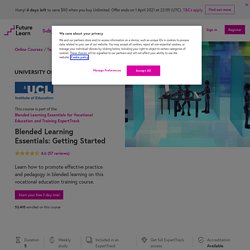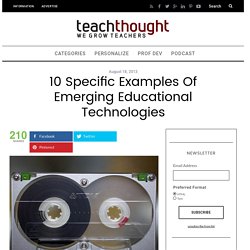

International Conference on Models of Engaged Learning and Teaching. September 1, 2016 support for research on MELT available May 1, 2017 Call for short papers July 1, 2017 Submission deadline for short papers Registration Details Submit a Short Paper I-MELT Flyer.

Blended Learning Essentials: Getting Started - University of Leeds. This course is designed to help anyone teaching in the vocational education and training (VET) sector understand the benefits of blended learning.

You will find out how to use technology more effectively to support your learners, and understand how to better embed it in your classroom. Supported by industry experts, you’ll connect with teaching and training professionals who understand the practical challenges of using blended learning. You’ll discover the importance of being able to blend digital learning methods into your teaching, to help your learners become familiar with the digital workplaces they’ll be joining.
The npj Science of Learning Community is an interactive online Community that brings together educators, neuroscientists, psychologists, and policymakers to understand how the brain learns. JOLT - Journal of Online Learning and Teaching. Learning & education. Rich Media in Online Instruction. Association of College & Research Libraries. Toolkit - ACRL Framework for Information Literacy Toolkit - LibGuides at ACRL. You can use the Toolkit resources in a variety of ways: for your individual professional development needs; to form a community of practice with your colleagues around the Framework and information literacy; and to develop workshops and professional development opportunities in your libraries and also for local, regional, and state-level events and conferences.

All materials that are prepared for and directly part of the toolkit are made available under a Creative Commons Attribution-Noncommercial (CC-BY-NC) license. Modules are designed to be adapted and tailored to the needs of the audience. You are free to pick and choose among the modules and the content; don’t feel that you have to start at the beginning and work through all the activities.
The Toolkit is designed for librarians. Home - ILP. Blended Librarian. In Support of Excellence - In Support of Excellence (Padagogy Wheel) - DIGITAL LITERACY. DigCompOrg Framework. The DigCompOrg framework has seven key elements and 15 sub-elements that are common to all education sectors.

Digital Literacies ANZ – Connecting digital learning with digital fluency. Digital Skills in Higher Education. The work and thoughts of the Digital Learning team in the College of Design and Social Context at RMIT University. What makes a successful online learner (July 2016) Curatr. First Friday Bring Social Learning to Retail with Kaboodle A version of this post first appeared on the HT2 Blog.

Earlier this year we launched a new digital learning and social collaboration platform built specifically with retailers in mind with our Partner, First Friday. 6-months post-launch and Kaboodle is starting to... read more How to Handle Your First Curatr Implementation: Advice from A Project Manager This post first appeared on the HT2 Blog. We all know finding the right learning platform is the hard part, right?! Future Tech: Proximity Beacons in Learning This post first appeared on the HT2 Blog. Popular ‘Introduction to the xAPI’ MOOC Returns to the Curatr Free Course Line-up As part of a lineup of free courses, Curatr’s parent company, HT2, have announced a revised version of the highly successful “Introduction to the xAPI” MOOC, which first ran in Summer 2015, and saw over 800 people from across the globe taking part in a 4-week... read more Curation, Copyright and the Law.
Podcasts - 2/7 - The eLearning Coach.
E-learning quality assurance standards, organizations and research. I am surprised how often academic colleagues argue that there are no quality standards for e-learning. Well, hello, I’m sorry, but there are and some of them are damned good. However, I was surprised to find while doing some research for a client that there is no single source where one can go to compare different quality standards for e-learning. So I’m starting a list here, and would appreciate it if readers could direct me to ones that I may have missed. (For more detailed information on some of these, see comments below).
How To Increase Learning Transfer. SumoMe When you are about to get surgery or your airplane is preparing for take off, don’t you desperately hope the surgeon or pilot had training that transfers to the real world?

With that same passion, we should try to ensure the training we design and develop is transferable to the workplace or to authentic life situations. Learning transfer refers to acquiring knowledge or skills in one context that enhances a person’s performance in another context. This is known as positive transfer. Assessments. Marcia Conner Assessments I developed the following assessments for various books and organizations.

Many were originally published in Learn More Now (Wiley, 2004), which also contains assessments on observation and collaboration styles. Learning Styles Assessment This easy to use inventory can help you assess your own approach to learning and how you take in information. I also have available an introduction to learning styles, an excerpt from chapter two on learning styles from Learn More Now, and a blog post offering my perspective on the value of learning styles entitled, “Learning Styles Gold.”
Motivation Styles Assessment This straightforward assessment can help you determine what drives you to action and what’s the reason behind why you want to learn. Direction Style Assessment This short checklist can help you identify if you prefer to learn from the big-picture or in a more detailed way. I developed this assessment for the Online University Consortium Search. Learning Styles - Learning skills from MindTools.com. Have you ever tried to learn something fairly simple, yet failed to grasp the key ideas?

Or tried to teach people and found that some were overwhelmed or confused by something quite basic? If so, you may have experienced a clash of learning styles: your learning preferences and those of your instructor or audience may not have been aligned. When this occurs, not only is it frustrating for everyone, the communication process breaks down and learning fails.
Train the Trainer Training Exercises & Resources. You are an expert in your field.

The management is very impressed with your skills and wants you to share it with others. You have been asked to give a talk to your fellow colleagues or anyone else in the company who is interested in the subject. The day of the presentation comes. Some of your colleagues have come from other branches of your organisation to attend your talk which is part of a series of presentations. Gamificación 1. A RECIPE for Meaningful Gamification.
The Thiagi Group - Improving Performance Playfully. 10 Specific Examples Of Emerging Educational Technologies. For over a decade, the New Media Consortium (NMC) has been charting the landscape of emerging technologies in teaching, learning, and creative inquiry on a global scale.

The NMC’s advisory board includes 750 technology experts and faculty members from colleges and universities in 40 countries, and is supported by the Consortium for School Networking (CoSN) and the International Society for Technology in Education (ISTE). The NMC’s latest research efforts, the NMC Horizon Report: 2013 K-12 Edition and the NMC Horizon Report: 2013 Higher Education Edition, were released this spring, and together highlight ten emerging technologies that will impact education over the course of the next five years: cloud computing, mobile learning, learning analytics, open content, 3D printing, MOOCs, virtual and remote laboratories, games and gamification, tablet computing, and wearable technology.
As an educator, you have probably heard about many of these technologies, if not all of them. 1. 2. 3. 4. 5. Learning and Assessment Resources. NMC Horizon Report. The NMC Horizon Report > 2016 Higher Education Edition is a collaborative effort between the NMC and the EDUCAUSE Learning Initiative (ELI). This 13th edition describes annual findings from the NMC Horizon Project, an ongoing research project designed to identify and describe emerging technologies likely to have an impact on learning, teaching, and creative inquiry in education.
Six key trends, six significant challenges, and six important developments in educational technology are placed directly in the context of their likely impact on the core missions of universities and colleges, and detailed in succinct, non-technical, and unbiased presentations. Each has been tied to essential questions of relevance, policy, leadership, and practice. Learning to teach online. Award Winning Pedagogical Support. 5 Powerful Questions Teachers Can Ask Students. My first year teaching a literacy coach came to observe my classroom. After the students left, she commented on how I asked the whole class a question, would wait just a few seconds, and then answer it myself. "It's cute," she added. Um, I don't think she thought it was so cute. I think she was treading lightly on the ever-so shaky ego of a brand-new teacher while still giving me some very necessary feedback.
So that day, I learned about wait/think time.